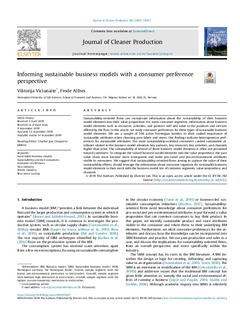| dc.contributor.author | Viciunaite, Viktorija | |
| dc.contributor.author | Alfnes, Frode | |
| dc.date.accessioned | 2019-10-04T12:10:02Z | |
| dc.date.available | 2019-10-04T12:10:02Z | |
| dc.date.created | 2019-09-27T13:59:02Z | |
| dc.date.issued | 2019 | |
| dc.identifier.citation | Journal of Cleaner Production, 2020, 242, 118417 | nb_NO |
| dc.identifier.issn | 0959-6526 | |
| dc.identifier.uri | http://hdl.handle.net/11250/2620355 | |
| dc.description.abstract | Sustainability-oriented firms can incorporate information about the sustainability of their business model elements into their value proposition. For some consumer segments, information about business model elements such as resources, activities, and partners will add value to the products and services offered by the firm. In this article, we study consumer preferences for these types of sustainable business model elements. We use a sample of 394 active Norwegian knitters to elicit ranked importance of sustainable attributes when choosing yarn labels and stores. Our findings indicate heterogeneous preferences for sustainable attributes. The most sustainability-oriented consumers ranked sustainable attributes related to the business model elements key partners, key resources, key activities, and channels higher than price. The sustainability of several of these business model elements is often not promoted toward customers. To integrate the valued business model elements into the value proposition, the yarn value chain must become more transparent and make pro-social and pro-environmental attributes visible to consumers. We suggest that sustainability-oriented firms aiming to capture the value of their sustainability efforts, should leverage the information about consumer segments for sustainable business model elements in their work with the business model trio of customer segments, value proposition, and channels. | nb_NO |
| dc.language.iso | eng | nb_NO |
| dc.rights | Attribution-NonCommercial-NoDerivatives 4.0 Internasjonal | * |
| dc.rights.uri | http://creativecommons.org/licenses/by-nc-nd/4.0/deed.no | * |
| dc.title | Informing sustainable business models with a consumer preference perspective | nb_NO |
| dc.type | Journal article | nb_NO |
| dc.type | Peer reviewed | nb_NO |
| dc.description.version | publishedVersion | nb_NO |
| dc.source.volume | 242 | nb_NO |
| dc.source.journal | Journal of Cleaner Production | nb_NO |
| dc.identifier.doi | https://doi.org/10.1016/j.jclepro.2019.118417 | |
| dc.identifier.cristin | 1730318 | |
| dc.relation.project | Norges forskningsråd: 244618 | nb_NO |
| cristin.unitcode | 192,11,0,0 | |
| cristin.unitname | Handelshøgskolen | |
| cristin.ispublished | true | |
| cristin.fulltext | original | |
| cristin.qualitycode | 2 | |

